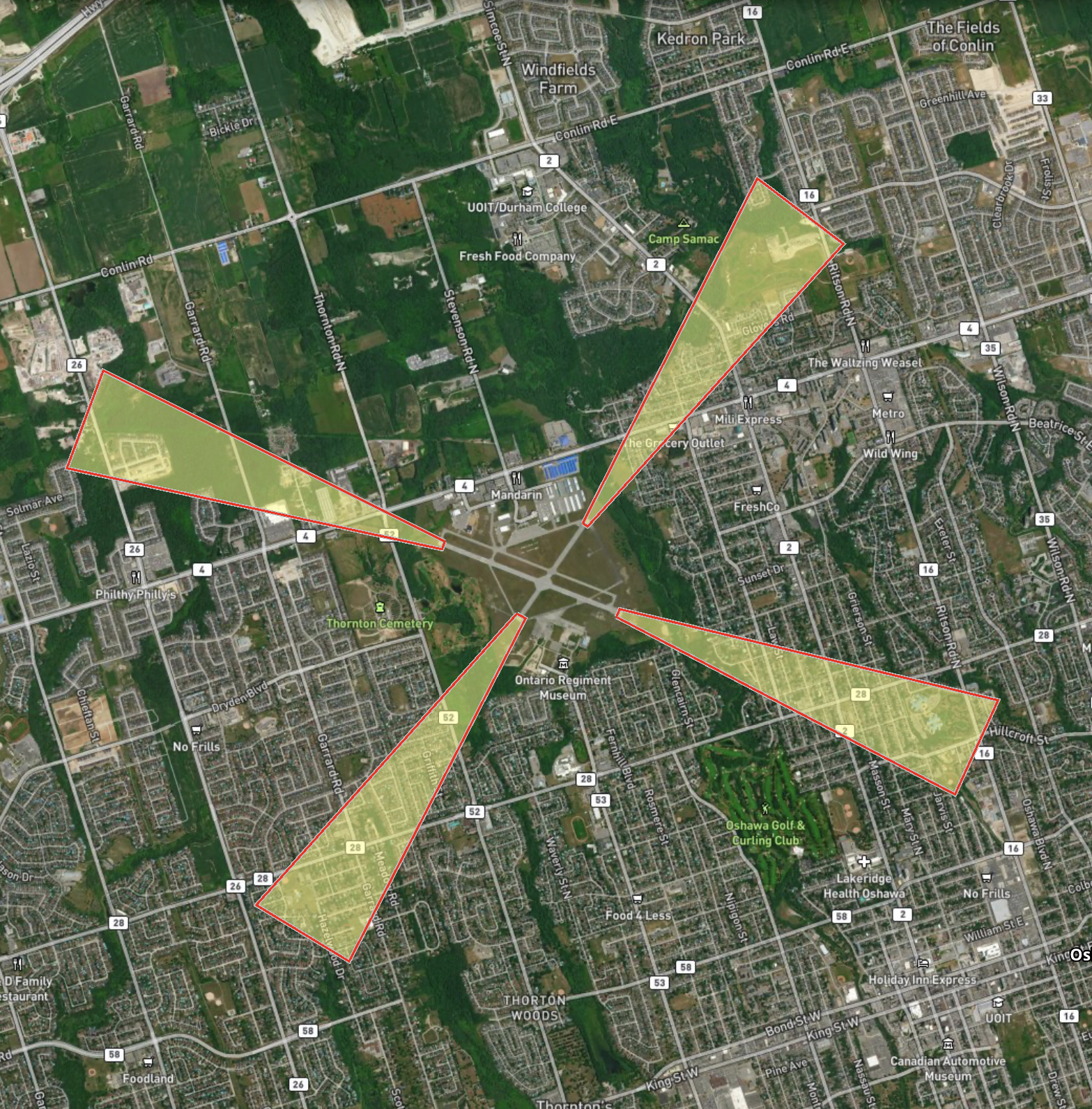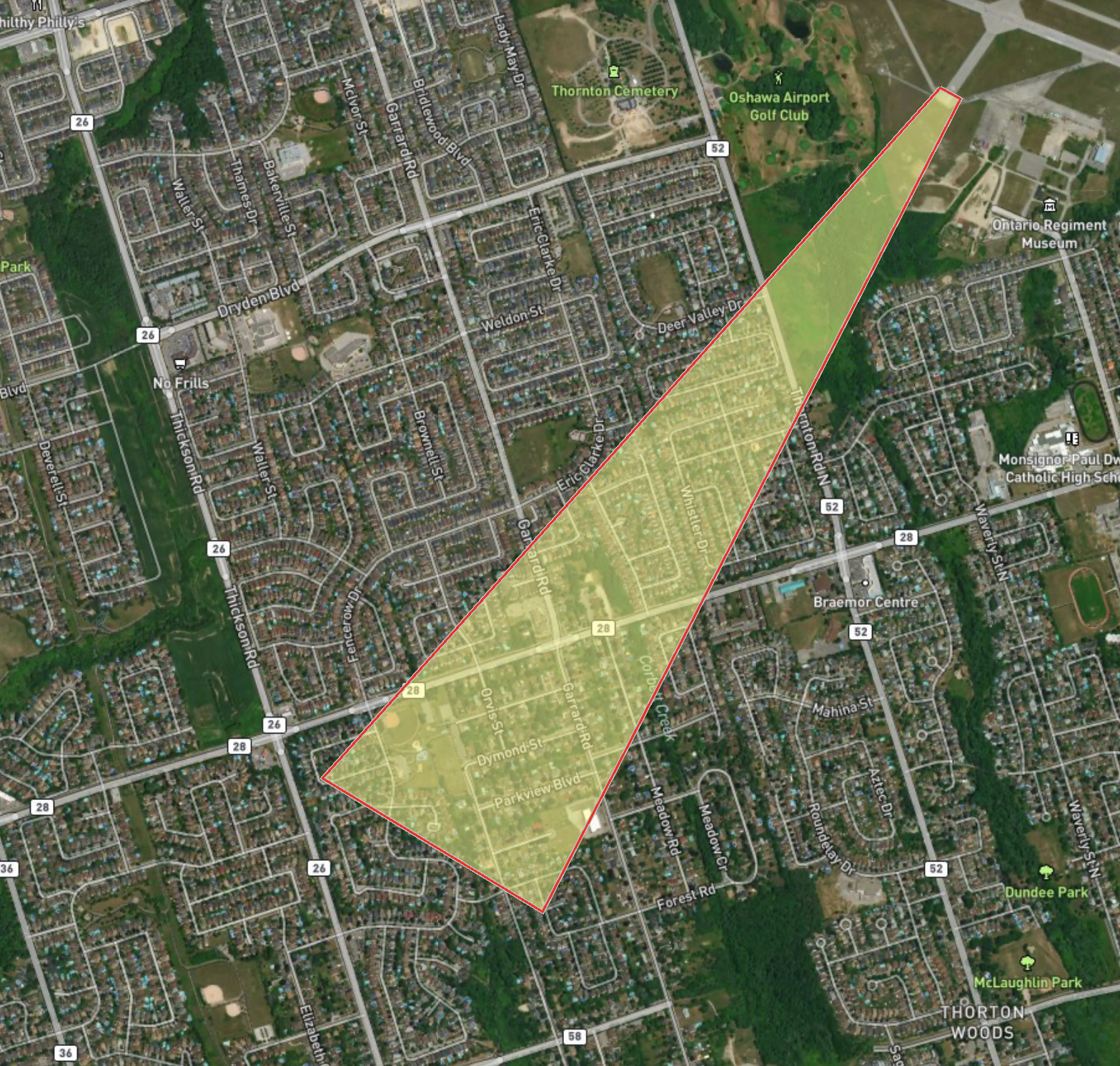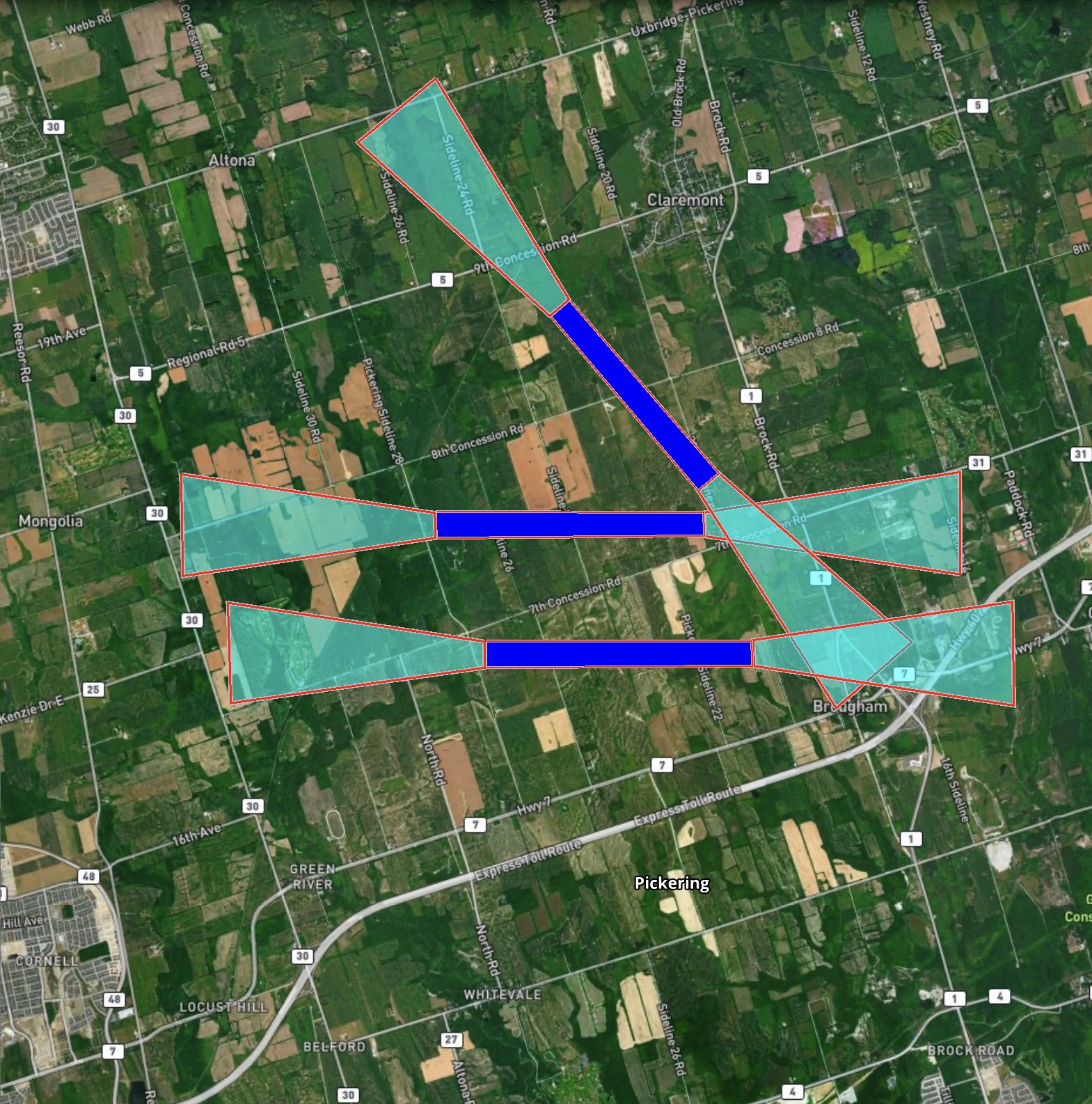The Oshawa Airport, located in the Greater Toronto Area, is very busy with residents complaining about the increasing noise from aircraft, despite new flight restrictions implemented by the Airport. Oshawa is part of Durham Region, one of the fastest growing areas in North America. This region and five of the local mayors, have a solution that will create jobs, increase safety and reduce noise pollution, by building a new airport in Pickering. A small number of individuals and corporations are lobbying to monopolize, for their own benefit, the valuable public land which was set aside by the Federal government for the airport. A local government MP has finally started to ask questions.
On October 1st 2020, the MP for Whitby, Ryan Turnbull, wrote to the Honourable Marc Garneau, Minister of Transport, concerned about increasing aircraft volumes and noise at Oshawa airport. In his letter, the MP made several observations that any pilot flying out of the airport could confirm. But his requested actions are misguided and will not resolve the issues. The MP’s description of the issues needs to be explored and the best solution determined.
MP Turnbull wrote, “the Oshawa Executive Airport has seen increased traffic volumes over the last several years, which has caused increasing noise pollution for certain segments of my community. Constituents report early morning flights as low as 200 feet above their homes, disrupting their lives daily.” MP Turnbull has requested that “NAV Canada investigate the flight paths” and that action be taken to improve the situation and to “find a mutually beneficial path forward”.
The MP’s observation is correct and timely, as Durham region grapples with plans for expanding its aviation infrastructure. Even in the middle of a pandemic, with travel from the US halted, Oshawa Airport’s traffic volume bounced back in September to exceed pre-pandemic levels.
In response to this growth, the Oshawa Airport has little choice but to enforce flight restrictions on aircraft movements and has started the process to evict a local flight school, with the loss of 70 jobs and millions in economic activity. This will jeopardize the advanced education and training that is critical to the success of the region’s air industry and connectivity. Yet this will not remove the pressure on the airport or the growing noise over the heads of local residents.

Let’s consider the situation at the Oshawa Airport. The airport was first established in 1941, during the second World War, to train pilots. The airport was transferred to Transport Canada in 1947. Over the years, Transport Canada created and updated the Oshawa Airport Zoning Regulations (OAZR). This zoning regulation identifies the approach surfaces for each runway. Consider one of the approaches defined in the regulations for a runway which extends for 2.5 kilometres from the end of the runway into Whitby. The regulations were written during a time when there was little or no residential development near the airport.

The zoning regulations define the approach surface slope as 1:50, meaning the slope from the end of the runway rises 1 metre vertically for each 50 metres travelled horizontally. Simple math shows that an aircraft could be as low as 50 metres(164 feet) above the ground 2,500 metres (2.5 kilometers) from the end of one of Oshawa’s runways and still be in compliance with the zoning regulation.
Ryan Turnbull, is correct in stating that aircraft can be seen flying 200 feet (61 metres ) above homes in Whitby, and those aircraft are 100% within regulations when they are doing so.
The height of aircraft above the ground will vary depending on terrain differences between the airport elevation, the specific local elevation, the distance of the aircraft from the runway, VFR or IFR flight rules and type of aircraft. Between the end of the runway and that 2.5 km end point, aircraft can even be lower than 50 m.
Notice that there are literally hundreds of homes under the approach surfaces at Oshawa, especially to the west and south. There are thousands of homes within several kilometers of the airport, many of which were built after 1984.
The situation begs fundamental questions: Why were these homes built under the airport’s approach surfaces? Why was their construction approved? The builders and the approval authorities knew, or should have known, about the airport and the regulations controlling its operation. People who bought these homes should have known or been informed of the airport situation before finalizing their purchase. So why complain about noise now?
Part of the answer is that the rapid growth of the eastern Toronto region and the increasing importance of aviation to our economy is changing the type, volume and role of traffic at Oshawa airport. In the past, a homeowner may not have minded or even noticed a light two seat Cessna 150 with a 100 horse power engine doing training overhead. Residents may even have cheered the arrival of the occasional DC3 with a just-in-time delivery of critical components for the city’s largest employer, the local General Motors automotive assembly plant. Times have changed.
A growing number of turbo props, helicopters, small jets and other commercial utility aircraft are now being added into the mix of General Aviation(GA) piston aircraft. New GA aircraft are also faster, more powerful and capable with features and avionics once seen only in larger passenger jets. All are mixing in with older training aircraft are such as the Cessna 172. This growing congestion, plus variations in aircraft speed, is creating longer lines of aircraft on the approach to the runway, further expanding the noise profile of the airport beyond its historical dimensions.
So, what can be done? Adding additional runways and infrastructure at Oshawa Airport to reduce the congestion is not possible. The airport is now surrounded by homes and business and is unable to significantly expand, even if the growing noise could be contained with restrictions. But a real solution is ready and waiting for the political green light from the Minister of Transport, Marc Garneau. A new, larger and more modern airport is being planned in near-by Pickering that will reduce the strain on Oshawa.

In contrast to Oshawa, the new airport in Pickering will be surrounded by a green space noise buffer and an economic development zone. Just as importantly, it will have the room for longer runways, overrun areas, hangars, passenger gates, fuel storage and the other services that make an airport work. In lieu of a final design, the new airport has been thoughtfully zoned with significantly larger 1:60 slope (shown above out to 3 km) and huge areas set aside for runways. A final design will refine and reduce this area but even now no homes not already owned by Transport Canada will be under the approach surfaces.
But this carefully organized solution is now in jeopardy. Recently, there has been a lobbying effort using the pandemic as an excuse to extend the land leases on the Pickering airport lands. This would result in taxpayer-owned land, assembled at great cost for economic development and an airport, being placed in the hands of a select few corporations and individuals for decades to come. This lobbying effort has included the misrepresentation by another MP (Jennifer O’Connell) of the contents of the ASA report which states that new aviation capacity is needed. These same special interests are showing contempt for the citizens of Oshawa and Whitby by misrepresenting the feasibility and human cost of expanding Oshawa airport.
Each year the new airport is delayed is money in the pockets of an anointed few, at great social and economic cost to rest of the citizens of Durham region. Draconian actions such as culling a flight school will not resolve the fundamental demand for local accessible safe aviation infrastructure. The only mutually beneficial path forward is to build Pickering Airport as quickly as possible.
All it will take to resolve this building crisis is for the MPs from Whitby, Oshawa and Pickering to show leadership by calling on the Minister of Transport to follow the suggestion of the KPMG ASA report to break ground on the new airport in 2026. The first steps in this process need to happen now, starting with Transport Canada initiating the environmental assessment process and to issue an Request For Proposal for the P3 development of Pickering Airport by private investors.
This new airport will improve aviation safety, and reduce aviation noise over the heads of hundreds of thousands of residents in Oshawa and Whitby. It will be an economic engine creating thousands of regional jobs. All that MP Ryan Turnbull has to do is ignore the lobbyists and special interest groups, listen to his voters, and join the five local mayors in their call to Build Pickering Airport Now!
References:
Stats Canada Aircraft Movement’s
KPMG ASA report, conclusions on Pages 334 point 3 and 5, business case on page 359, 373, 374
Oshawa Business plan workshop Sept 2020.
Oshawa Airport Noise Management Procedures
MP Ryan Turnbull, Jennifer OConnell with Justin Trudeau
Timelapse – Google Earth Engine
The Oshawa Airport zoning regulations
There is no strain at the CYOO airport besides pure political strain. A very slanted and passive aggressive report. We do not need the Pickering Airport we just need a better managed CYOO airport by competent staff and educated councillors.
Wishful thinking dosnt make congestion and noise go away. It dosnt stop growth or handle change. Your fake email and info Says volumes about your “creditable info“
More life FRIEND of Pickering Airport.. this is just funny
Oshawa airport should be closed ASAP , local residents feel sick of noise due to airport.
There is misinformation in this post that needs to be corrected.
I suspect that the airport zoning regulations you refer to affect the height of buildings in close proximity to the airport; this would prevent the construction of tall buildings along the approach paths to the runways that could potentially interfere with safe flying. Your assertion, however, that aircraft can legally fly at an altitude of 200 feet above ground level (AGL) in Whitby is completely wrong. Pilots are required to adhere to the Canadian Aviation Regulations (CARs). Zoning regulations have no bearing on how an aircraft is piloted. According to the CARs, aircraft must maintain an altitude of at least 1000 feet AGL over a built-up area, except for the purpose of taking off and landing. At Oshawa, aircraft may not descend below 1000 feet above sea level, or about 550′ AGL, until they are lined up with the landing runway. At any rate, the required descent rate is a 3-degree slope, so an altitude of 200′ AGL isn’t reached until the aircraft is within a quarter mile of the runway.
Think logically about what you are suggesting in your article. 200 feet is the length of a hockey rink. Aircraft tooling around at that height would risk colliding with any number of buildings or cell towers in Whitby or Oshawa. In the event of an engine failure, a plane would almost certainly crash into a residential area. One of the primary reasons for maintaining the altitudes I referenced above is to give a pilot on landing approach the ability to safely glide to the runway in the event of engine failure. Quite apart from being illegal, flying at the altitudes you suggest is outright dangerous. It does not happen, ever, regardless of MP Turnbull’s assertions.
While you may support the construction of an airport in Pickering, using false and inflammatory information to support your case is counterproductive at best and, I would suggest, irresponsible as well.
Hi Steve, thank you for reading the post, for your interest and your comments.
First let me assure you that, as an active flight instructor flying out of both buttonville and oshawa airports for decades, that I am well aware of the CARS and of the difference between the zoning regulations for the Oshawa airport and the rules of the air.
I wish to assure you that all pilots landing at any airport strive to follow an appropriate stable glide slope into an airports runway. While IFR rated pilots on an instrument flight plan are expected to be following an IFR procedure with a closely scripted decent rate, VFR ( visual flight rules ) pilots are eyeballing it.
All the IFR procedures at oshawa have a 3 degree approach slope for the approaches to Oshawa’s runways (05, 23, 12 and 30.) At other airports these approaches can be even steeper ( Toronto city center for instance).
VFR pilots, especial student pilots are not flying a ridged glide slope. With a busy circuit ( every Good weather day at oshawa) a pilot can find himself pushed out to a four mile final. While an experienced pilot will know not to descend when he turns base on an extended downwind, less experienced and student pilots often follow a rigid mantra of descending up to 500 ft on base, and then after turning final, continuing a shallow decent, slow, low, with power on to make the runway.
This is happening to some degree every single day at oshawa, and other busy airports that have VFR traffic. To be blunt there is nothing wrong with it, the zoning around airports are there to accommodate such deviations safely.
Oshawa’s problem is not VFR pilots, it is bad planning. Oshawa’s noise issue is caused by the lack of planning that allowed homes to be built close to the airport underneath an active approach path to a runway.
Wishful thinking and denial is not going to change Oshawa’s current geography. What is needed is leadership to properly plan the future coexistence of local accessible aviation infrastructure and the community’s they serve.
This website was founded to counter misinformation, we would never under any conditions push misinformation in support of a cause as some who are opposed to the new airport are doing.
Mark Brooks.